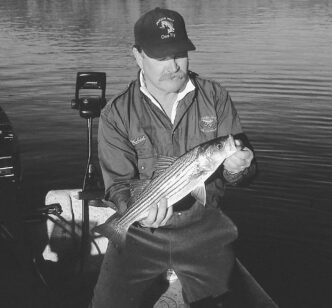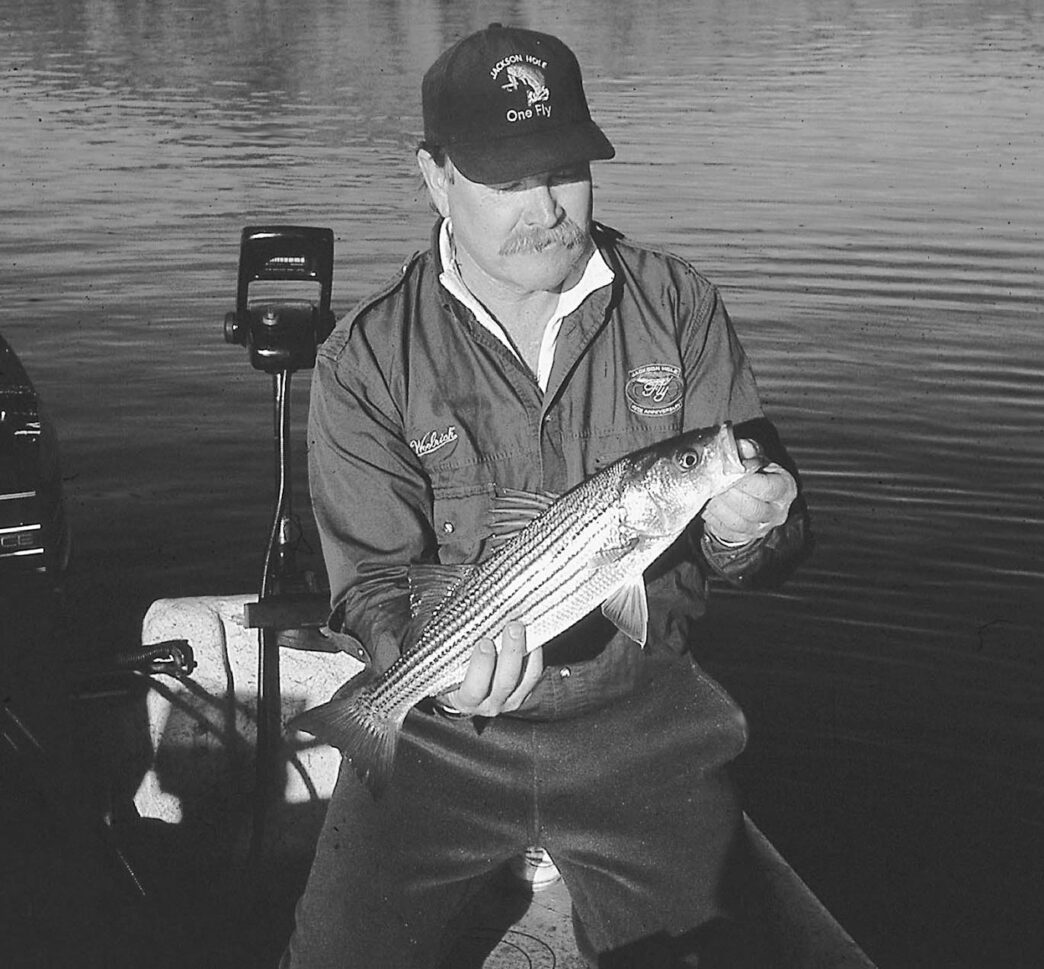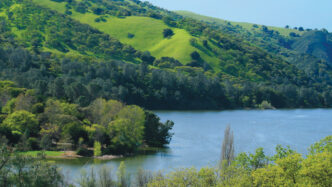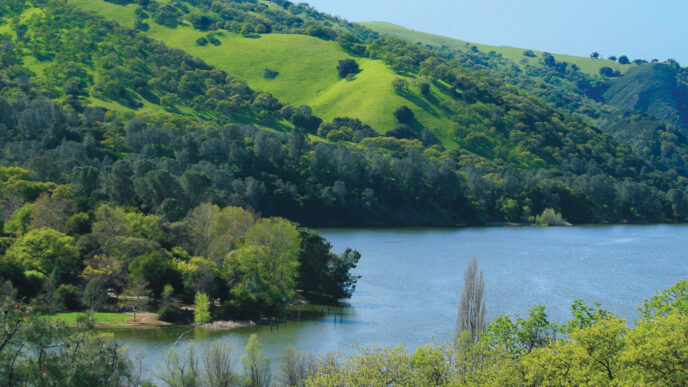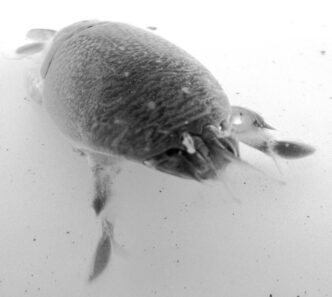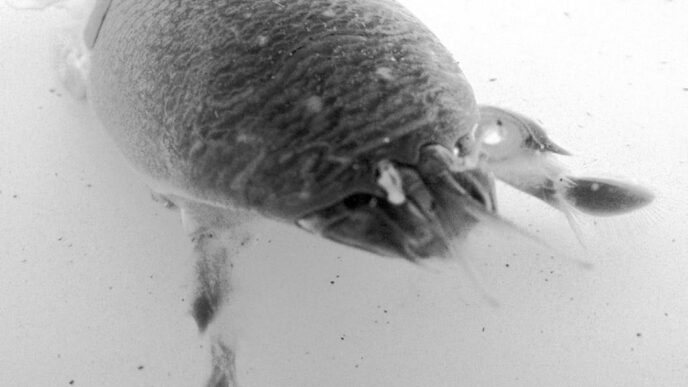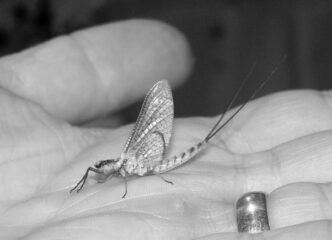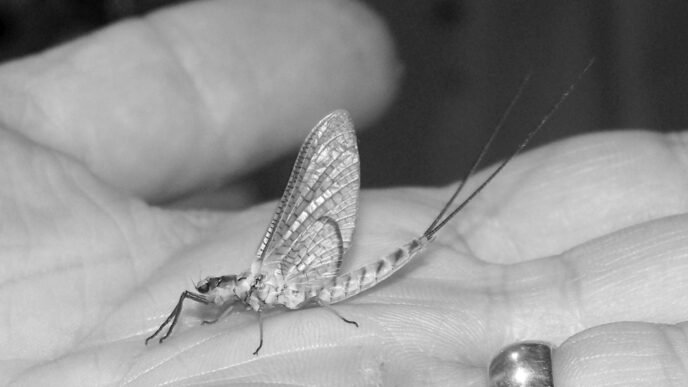If you look at an overhead photo or map of Lake Skinner, it appears for all the world like a big tooth lying on its side. The top of the tooth is formed by the dam at the west end of the lake, and the long roots are the twin back bays on the shallow east end. The campground, launch facilities, marina, and store are located on the bump of land between the two roots.
Skinner is located in the softly rolling hills of wine country northeast of Temecula and Rancho California and covers a modest 1,200 or so surface acres. One of the things I like best about Lake Skinner, besides the excellent fishing, is the sense of solitude you get despite its proximity to several large communities. The north shore of the lake has no roads or trails — the land there is a nature preserve. Much of the rest of the surrounding land is similarly empty — ranch property with few roads and almost no structures on the horizon. You feel the peace and quiet of nature, yet you can be into a modern cityscape within minutes of exiting the lake.
Like many Southern California still waters, Lake Skinner is a dual-ownership facility. The water and the reservoir are owned by the Metropolitan Water District, the largest water supplier in the Southland. For recreational purposes, however, it is operated as part of the Riverside County Parks system. It is really a family-oriented playground, with generous camping facilities, things for kids to do, and plenty of fishing opportunities to keep the anglers in the household happy.
Where to Fish
The area around the dam is, of course, mostly deep water. By contrast, the east end of the lake is quite shallow and has extensive tule growth, which acts as a massive nursery and hiding place for baitfish and small game fish. The north shore, for the most part, is rather featureless and steep as you travel from the west side and reach a spot that’s across from the marina. Then you will find numerous coves covered in brush and tules all the way to the back of the lake.
There is one major attraction on the north side, and that is the spot where aqueduct water enters the impoundment. It is marked by a buoy line, but the fishing can be excellent if the water is running in, because the current attracts both striped bass and largemouth bass to feed on the baitfish being swept into the lake. This can be a productive place for the fly angler, but at times it produces better for conventional-tackle anglers who can cast big lures from the buoy line well up to where the whitewater boils
The south side of Lake Skinner has a more convoluted shoreline, and the many coves have brush and tules in the water. This area often offers good bass and panfish angling, and you can prospect for hours along these coves and points. There is some limited foot access for a portion of the south side.
I used to fly fish for bass from the bank along the south shore, following the rough trail from cove to cove and casting poppers and hair bugs to some pretty cover and structure. These days, I mostly fish from a boat, but still enjoy the same area, because in the spring it contains a decent number of bass of very respectable size, plus large panfish.
Around the bulge of land that holds the campground and the dual launch ramps, a number of coves and points have fish, and many of these are accessible on foot, as well. Indeed, the launch ramps themselves are often the scene of excellent angling, particularly in the winter months, when trout are stocked by Riverside County. At this time, the state is not stocking trout at Skinner due to the ongoing efforts to adhere to court-imposed regulations following a lawsuit by the Center for Biological Diversity. Quinn Granfors, the local Department of Fish and Game’s lakes biologist, told me he’d like to stock state-raised trout at Skinner again and hopes that the legal process will eventually allow stocking to resume.
I won’t detail the trout angling, because it is entirely for stocked fish, but I will say that in an area that has very little in the way of wild or native trout fisheries, the county-supplied fish are welcomed by anglers at places such as Skinner and do provide a minimal level of sport for the winter fly fisher.
Because Skinner is a water-delivery stopover connected to two aqueduct systems, it gets whatever swims in the upstream portions of both. Always known as a fair bass and bluegill lake, it finally became a striped bass fishery a couple of decades ago, with these fish coming from Northern California and from the Colorado River. Striped bass are in fact the primary game fish sought by anglers at Skinner, but winter trout, largemouth bass, and bluegills are certainly not ignored.
The lake also, alas, has quagga mussels, an invasive shellfish that clogs water pipes and other water-handling equipment and that has been a giant pain in the tail for water managers and anglers since the species appeared in the state a few years ago. Despite the unplanned introduction of quagga mussels and the boat inspection system created to attempt to control it, Lake Skinner is still a great destination for local fly anglers.
In addition to the good fishing, Skinner’s regulations lend themselves to a better, more tranquil fishing experience. Much of the lake is a no-wake zone, with a 10-mile-per-hour-speed limit across the entire impoundment, and that is one very large reason for the laid-back atmosphere. A rule against body contact with the water also keeps personal watercraft and waterskiers away — both rules contribute to better and quieter fishing.
Striped Bass
Skinner has developed a solid reputation for the hordes of striped bass that roam the lake. They are there in huge numbers (although it is still quite possible for even good anglers to go home emptyhanded), and if you hit it right, the catch numbers can be very high for fish up to three or four pounds, with an occasional larger fish. Every so often, somebody connects with a striped bass in the 10-to-20-pound range, most times on a lure, but sometimes on a streamer fly drifted on a sinking line.
The standard approach at Skinner is the same as it is for targeting stripers at Diamond Valley, Silverwood, and the lakes of the Colorado River. Practitioners use quick-sinking lines to take a small white streamer — often the well-known BS Fly, nicknamed for guide Bob Slamal, who made the fly famous at Skinner — into fairly deep water. It is a game of drifting or slow trolling with the fly as deep as you can get it. This deep presentation is accompanied by constant short strips and releases of the line to make the fly dart ahead and then fall back in a rhythmic pulsation that provokes the striped bass to attack it. At times, though, you’ll find the stripers in packs attacking schools of threadfin shad or silversides, and then the angling becomes fast and furious. You can fish a slender pencil popper (also mostly in white or silver) on the surface and get some sizeable fish in just a few minutes.
Quinn Granfors told me recently he would like every striper caught, even by fly anglers, to be removed. “Skinner is overpopulated with small fish, and removing a lot of them would give us larger striped bass and improve the fishery,” he said. “The smaller stripers are getting skinny. Catchand-release fishing is actually hurting the fishery.” He recommends that anglers take their limit of stripers wherever they fish in Southern California if they want improved striped bass fishing. “People toss the little ones back, saying, ‘I want bigger stripers,’ ” Granfors laughed. “I tell them, ‘If you want bigger stripers, keep these little ones and you’ll create bigger stripers.’ ”
Al Thorson, the owner of a local avocado ranch who fishes Skinner several days each week, says he agrees and often takes home limits of striped bass, which go toward frequent fish fries and dinner parties held at his ranch. Al used to fish with lures, but switched to fly fishing years ago and mainly pursues the stripers, although he told me he’s caught some really big largemouth bass on the fly, as well.
Largemouth Bass
According to Granfors, the largemouth bass population has grown into a real fishery over the last few years, despite the presence of striped bass and the fact that the Metropolitan Water District has constantly shot down attempts to enhance habitat on the relatively barren bottom. DFG biologist Mike Guisti, who was the lakes biologist prior to Quinn getting the job, tried for more than a decade to get structure into Lake Skinner, but was unable to do so. Still, the modest amount of structure and tule habitat that Skinner does hold supports a pretty fair population of bass, boosted over the years by restocking from nearby Lake Matthews.
“The bass fishery is outstanding. For Riverside County, I think it is the public’s best chance to catch a fish over 10 pounds,” Granfors told me. “It’s better even than Diamond Valley. Absolutely better.”
That’s quite a statement coming from a normally conservative biologist. They tend to understate things, preferring to err on the cautious side of such prognostications. Granfors manages the fishery at both Lake Skinner and Diamond Valley, and while Diamond Valley has been making all the bass news for the last couple of years, his professional judgment ought to make bass anglers sit up and take notice.
What’s more, from the purely aesthetic standpoint, Skinner is, I think, a better place to fish than Diamond Valley. The only other place that gives Southern California fly anglers a similar feeling is Barrett Lake in southern San Diego County. Not only does it have no development around its shores, the lake is smaller than Diamond Valley and much less intimidating to the first-time visitor. It is shallower and lends itself more to top-water presentations of bass bugs and poppers during the spring than does its larger neighbor. While the striped bass anglers fish with sinking lines and deeply presented flies, the bass angler, at least in the spring, will be able to profit from a floating line and surface presentations.
The drawbacks of fishing flies at Lake Skinner are just the same as they are at Diamond Valley. No float tubes are allowed at either lake, and at both, the amount of shore fishing available is minimal compared with what you can cover with a boat. Sit-in kayaks can be used at Skinner (siton-tops are not allowed), and that should entice some anglers to use these craft to take advantage of the great bass fishing.
Panfish
The other fishery of interest is the lake’s bluegill population. Some of these fish are “the size of a paper plate,” as the saying goes. Skinner bluegills are not to be ignored. Getting hold of a slab-sided bluegill weighing a couple of pounds on a light rod and line is a real treat. Most of the larger fish will be caught in a few feet of water around the best brush and tule structure in the lake, mostly on the south and east sides.
In the spring and early summer, a small popping bug cast to shady spots in coves and along the generous stands of tules will produce some whopper bluegills. This is also a sport fish that readily accepts nymphs and such generic flies as a Woolly Bugger. Even a small bluegill with give you a tussle on a light fly rod, and really big ones will make you think you’ve hooked a sizeable largemouth until you get it close enough to the boat to tell.
Skinner used to be noted for its excellent crappie fishing. Indeed, a decade ago, stringers of crappies almost too heavy for two people to lift were pretty common here. Sadly, that fishery no longer exists. While there may still be crappies living in the lake, nobody has caught anything resembling the former size and weight of fish in years. For all practical purposes, crappies are extinct here. Nobody, knows why, not even the biologists.
How would I rate Skinner as a fly fisher’s destination? For the trout enthusiast, it is adequate. For the warmwater angler who prizes a hard-fighting striped bass on the fly or dreams of big largemouth bass making gill-rattling leaps or crashing attacks on a surface bug and who can gladly spend a day casting for beautiful bluegills in clear water, it is an outstanding lake. If you like a bit of fly fishing the way it used to be, without the zoom of waterskiers and party boats, and prefer instead to listen to the line sizzle off your reel as a striper heads for the center of the lake, this is the place to be.
If You Go…
To reach Lake Skinner from almost anywhere in the Los Angeles area, take the 15 freeway to Temecula and get off at Winchester Road (Highway 79), heading north toward Hemet. Turn right on Benton Road, go to the end, and turn right to reach the main gate. Or take the 15 freeway to Rancho California Road and go north 10 miles to the main gate.
The day-use fee at Lake Skinner is $5.00; camping: $19.00 to $25.00; fishing: $4.00 for age 16 and up, $2.00 for ages 5 to 16; launch fee for private boats: $2.00. The phone number for the park office is (951) 926-1541. The marina phone is (951) 926-8515, and the Lake Skinner Store phone is (951) 926-1505.
While Skinner is operated as a Riverside County park, the Metropolitan Water District, which controls the water in the lake, determines the boating regulations there and at Diamond Valley. Only four-stroke outboards and post-2001 direct fuel-injection two-stroke engines that comply with California Air Resources Board standards are allowed on the water.
Boating anglers need to get their boat inspected for quagga mussel contamination before launch. Kayaks are allowed on the water, but float tubes are not at this time. Boats must be at least 12 feet long, 42 inches wide, and have 12 inches of freeboard at idle speed. Multihulled boats must have solid and fixed decking. Kayaks must be at least 10 feet long, nonbailing, and with seating for all passengers inside the boat. Sit-on-top kayaks are not allowed. The speed limit for all watercraft on Lake Skinner is 10 miles per hour. The maximum speed within 100 feet of the shore, dams, and other operational structures and in marinas areas is 5 miles per hour.
Camping is a popular activity at the lake, with 300 developed campsites for both tent and RV campers. Full hookups and showers are available, along with a convenient camp store.
Anglers interested in guide service should contact Bob Slamal via e-mail at riversideskiandsport@yahoo.com.
Richard Alden Bean



